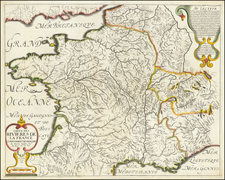An Important Map of Lorient and Port-Louis, at the Time It Was Transferred From the French East India Company To The French Government
Finely detailed map of the area around Lorient, on the south coast of Bretagne, published in 1771.
Oriented with west at the top, exceptionally detailed map Lorient and Port Louis, published shortly after the height of its importance in the Triangle Trade and just before it became a primary base for the privateers (state sponsored pirates) who would play a significant role in the American Revolutionary War.
Issued 2 years after the commercial enclave belonging to the French Compangnie de Indes (French East India Company) was acquired by the French Government, the plan provides an exceptionally detailed look at the extensive holdings of the Company, including depots, wharves, warehouses, offices, shipyards, etc., as well as the protective fortifications and neighboring towns.
A fine detailed look at France's major harbor at the height of its historical importance.
Port Louis and Lorient
At the beginning of the 17th century, merchants who were trading with India established warehouses in Port-Louis. They later built additional warehouses across the bay in 1628, at the location which became known as "L'Orient" (the Orient in French).
In 1664, Jean-Baptiste Colbert founded the French East Indies Company. In June 1666, an ordinance of Louis XIV granted lands of Port-Louis to the company, along with Faouédic on the other side of the river. One of its directors, Denis Langlois, bought lands at the confluence of the Scorff and the Blavet rivers, and built slipways. At first, Lorient only served as a subsidiary of Port-Louis, where offices and warehouses were located. The following years, the operation was almost abandoned, but in 1675, during the Franco-Dutch War, the French East Indies Company scrapped its base in Le Havre since it was too exposed during wartime, and transferred its infrastructures to l'Enclot, out of which Lorient grew. The company then erected a chapel, workshops, forges, and offices, leaving Port-Louis permanently.
The French Royal Navy opened a base there in 1690, under the command of Colbert de Seignelay, who inherited his father's position as Secretary of State of the Navy. At the same time, privateers from Saint-Malo took shelter there. In 1700, the town grew out of l'Enclot following a law forcing people to leave the domain to move to the Faouédic heath. By 1702, there were about 6,000 inhabitants in Lorient.
The town experienced a period of growth when John Law formed the Perpetual Company of the Indies by absorbing other chartered companies (including the French East India Company), and chose Lorient as its operative base. Despite the economic bubble caused by the Company in 1720, the city was still growing as it took part in the Atlantic triangular slave trade. From 1720 to 1790, 156 ships transported an estimated 43,000 slaves. In 1732, the Company decided to transfer its sales headquarters from Nantes to Lorient, and asked architect Jacques Gabriel to raise new buildings out of dimension stones to host these new activities, and to embellish the L'Enclos domain. Sales began in 1734, peaking up to 25 million livres tournois In 1769, the Company's monopoly ended with the scrapping of the company itself, under the influence of the physiocrats.
The Company was not able to maintain itself financially, and it was abolished in 1769. In 1770, King Louis XVI issued an edict that required the Company to transfer to the state all its properties, in return for which the King agreed to pay all of the Company's debts and obligations. The French government then took over the shipyards as a naval port and arsenal.
In 1769, the city evolved into a full-scale naval base for the Royal Navy.From 1775 on, the American revolutionary war brought a surge in activity, as many privateers hailed from Lorient. When the war ended, transatlantic lines opened to the United States, and in 1785, a new commercial company started under Calonne's tutelage (then Controller-General of Finances) with the same goal as the previous entities, i.e. conducting trade in India and China, with again Lorient standing as its operative base.
Rarity
The map is very rare. We note an appearance in a Frederik Muller catalogue, Topographie de L'Europe . . . in 1903 (Items 2348).
The BnF holds copies of the map dated 1771 and 1779.









![Generale Caert van Vranckryck [General Map of France]](https://storage.googleapis.com/raremaps/img/small/93273.jpg)


![(France) Gallia Antiqua Ex Aevi Romani Monumentis Eruta et Serenissimi Carnutum Ducis Munificentia Publici Juris Facta [Ancient Gaul From the Roman Age, the erudite Monuments. . .]](https://storage.googleapis.com/raremaps/img/small/82019.jpg)
![[ France ] Galliae Regionis Nova Descriptio](https://storage.googleapis.com/raremaps/img/small/81285.jpg)
![[La Rochelle] Rochella Munitissimum Galliae Opp.](https://storage.googleapis.com/raremaps/img/small/77250.jpg)